Unit 4 Where’s my schoolbag? 教学设计
文档属性
| 名称 | Unit 4 Where’s my schoolbag? 教学设计 | 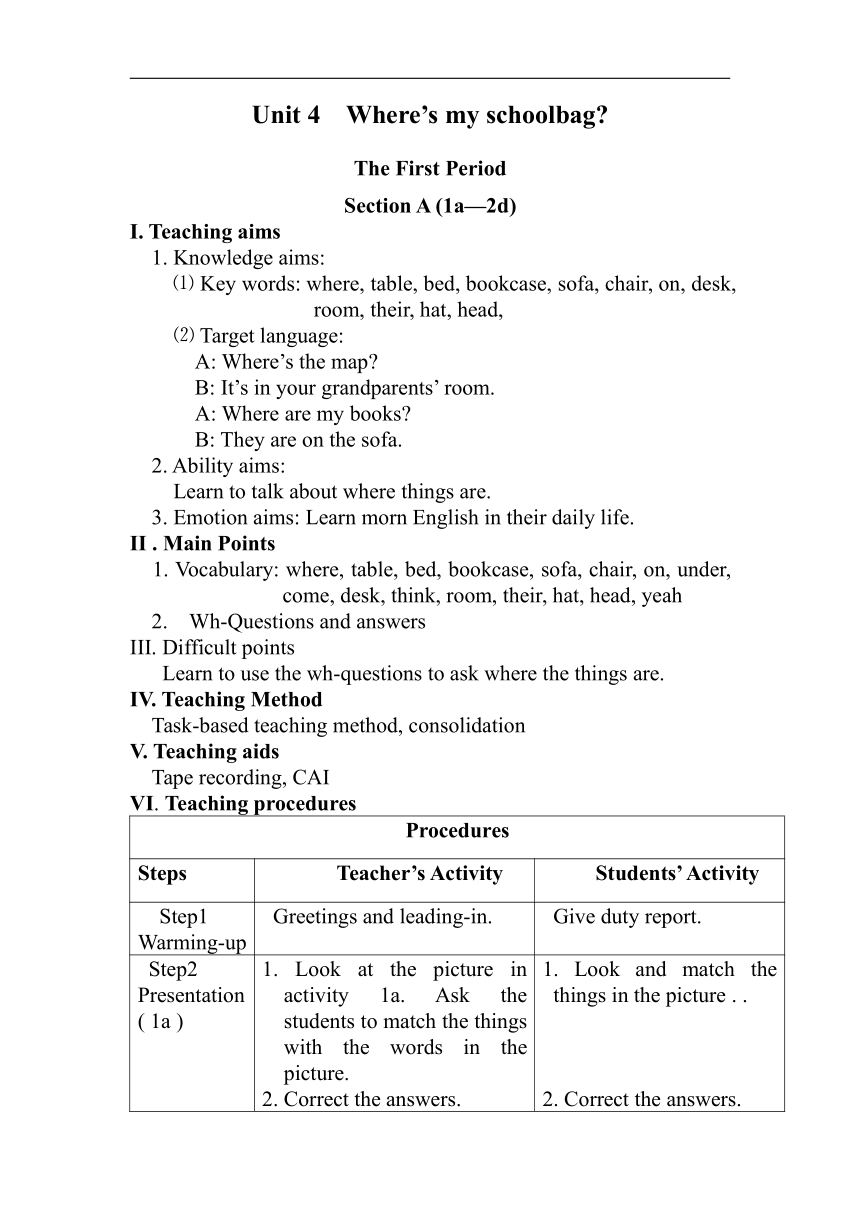 | |
| 格式 | zip | ||
| 文件大小 | 30.0KB | ||
| 资源类型 | 教案 | ||
| 版本资源 | 人教新目标(Go for it)版 | ||
| 科目 | 英语 | ||
| 更新时间 | 2013-10-16 22:14:15 | ||
图片预览

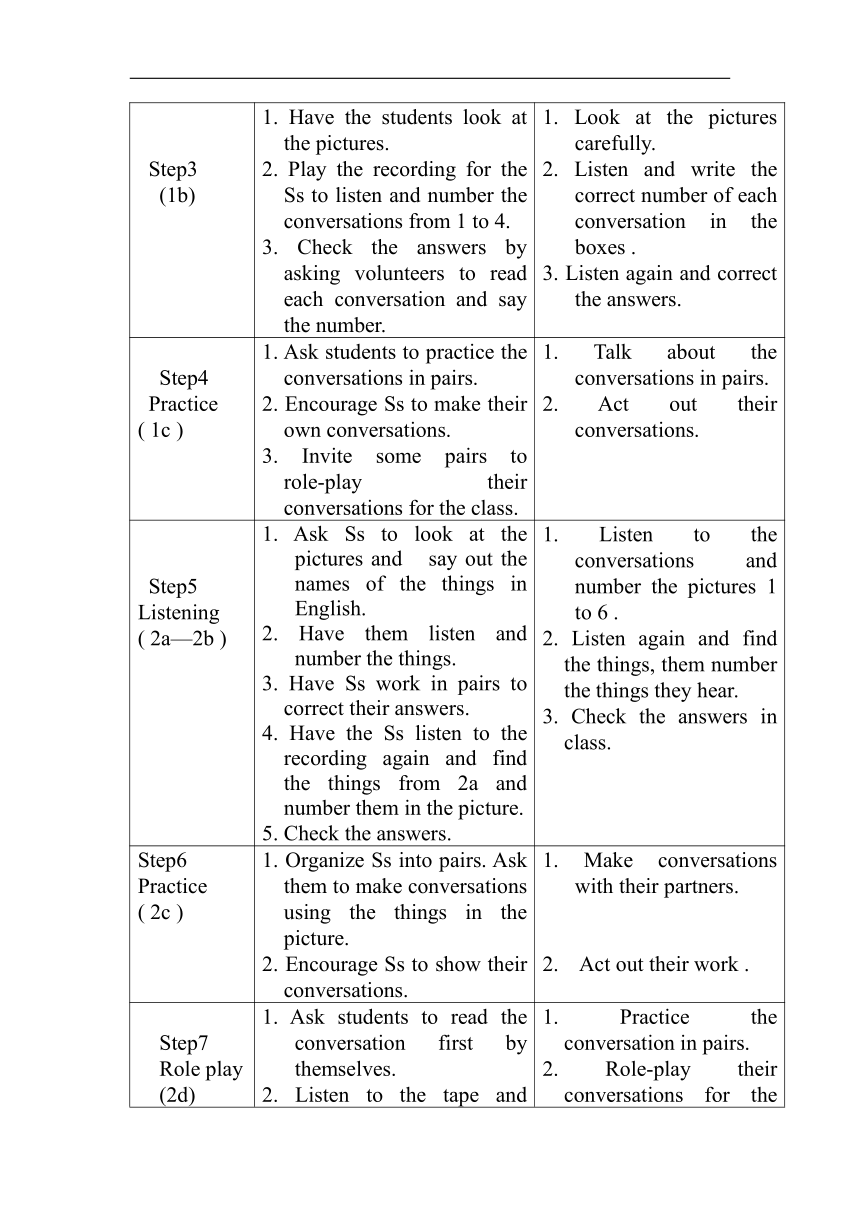
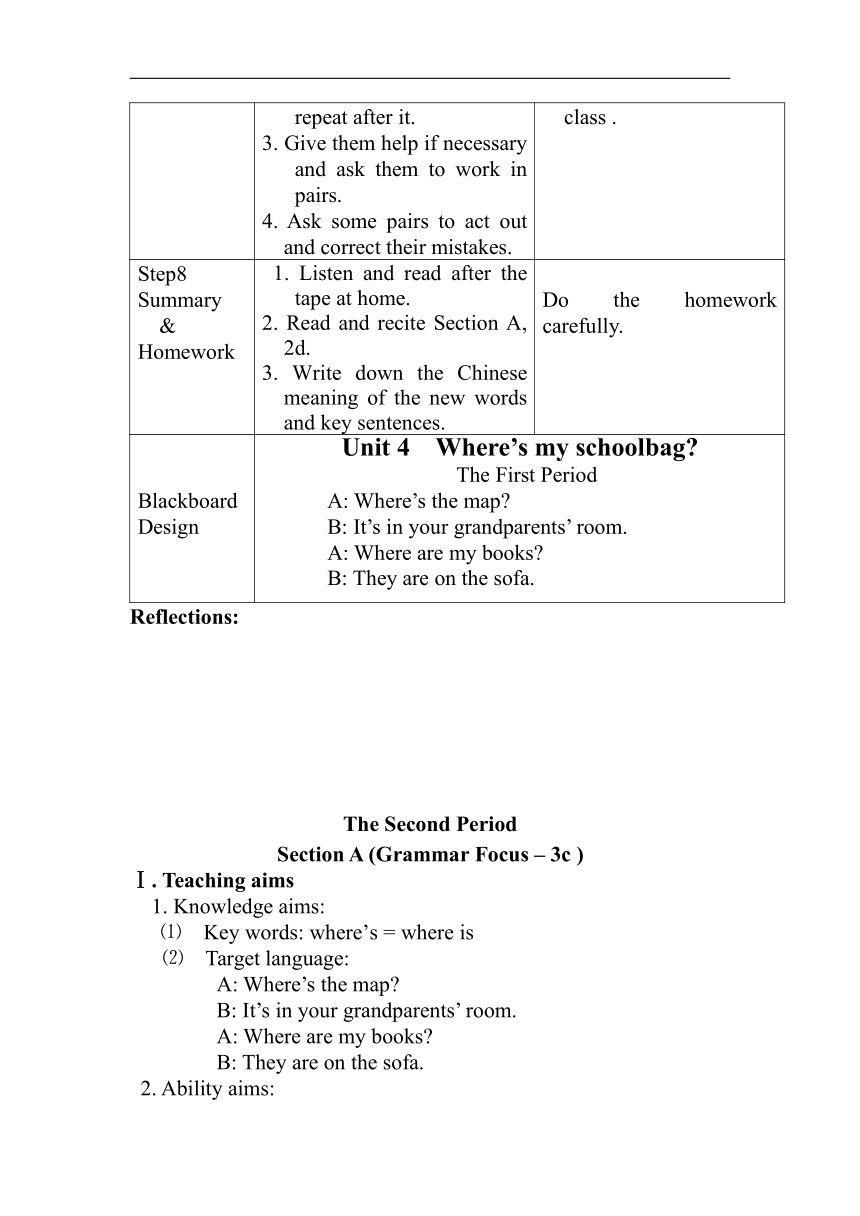
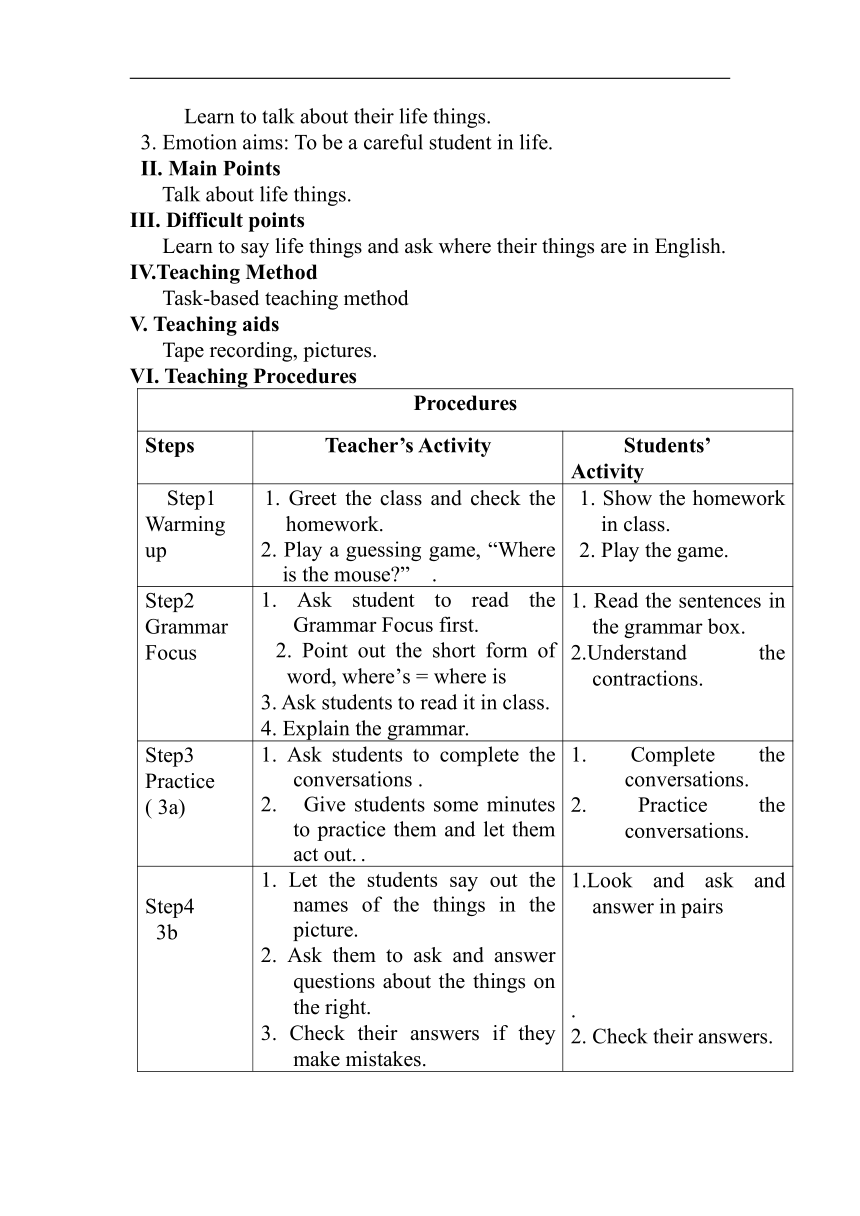
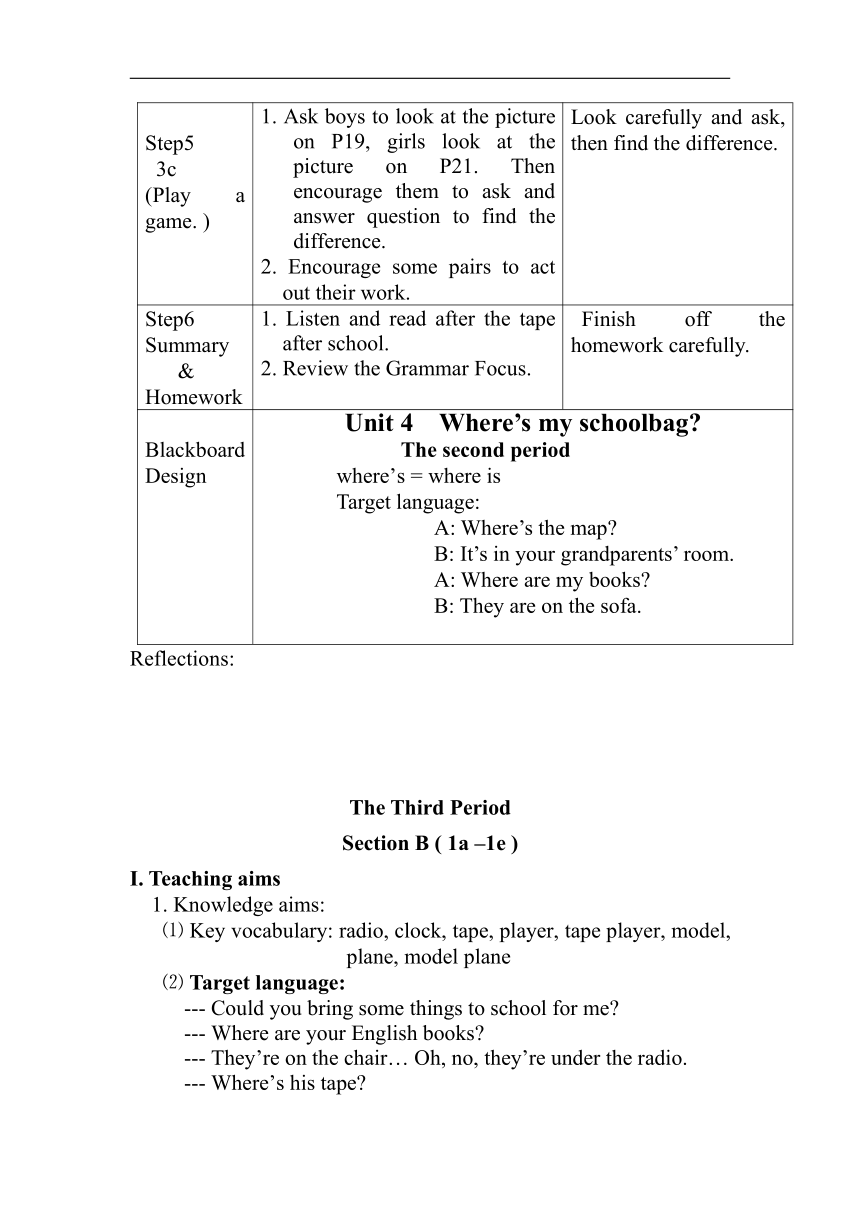
文档简介
Unit 4 Where’s my schoolbag
The First Period
Section A (1a—2d)
I. Teaching aims
1. Knowledge aims:
⑴ Key words: where, table, bed, bookcase, sofa, chair, on, desk, room, their, hat, head,
⑵ Target language:
A: Where’s the map
B: It’s in your grandparents’ room.
A: Where are my books
B: They are on the sofa.
2. Ability aims:
Learn to talk about where things are.
3. Emotion aims: Learn morn English in their daily life.
II . Main Points
1. Vocabulary: where, table, bed, bookcase, sofa, chair, on, under, come, desk, think, room, their, hat, head, yeah
2. Wh-Questions and answers
III. Difficult points
Learn to use the wh-questions to ask where the things are.
IV. Teaching Method
Task-based teaching method, consolidation
V. Teaching aids
Tape recording, CAI
VI. Teaching procedures
Procedures
Steps Teacher’s Activity Students’ Activity
Step1Warming-up Greetings and leading-in. Give duty report.
Step2Presentation( 1a ) 1. Look at the picture in activity 1a. Ask the students to match the things with the words in the picture.2. Correct the answers. 1. Look and match the things in the picture . .2. Correct the answers.
Step3(1b) 1. Have the students look at the pictures.2. Play the recording for the Ss to listen and number the conversations from 1 to 4.3. Check the answers by asking volunteers to read each conversation and say the number. 1. Look at the pictures carefully.2. Listen and write the correct number of each conversation in the boxes .3. Listen again and correct the answers.
Step4Practice( 1c ) 1. Ask students to practice the conversations in pairs.2. Encourage Ss to make their own conversations.3. Invite some pairs to role-play their conversations for the class. 1. Talk about the conversations in pairs.2. Act out their conversations.
Step5Listening( 2a—2b ) 1. Ask Ss to look at the pictures and say out the names of the things in English.2. Have them listen and number the things.3. Have Ss work in pairs to correct their answers.4. Have the Ss listen to the recording again and find the things from 2a and number them in the picture.5. Check the answers. 1. Listen to the conversations and number the pictures 1 to 6 .2. Listen again and find the things, them number the things they hear.3. Check the answers in class.
Step6Practice( 2c ) 1. Organize Ss into pairs. Ask them to make conversations using the things in the picture.2. Encourage Ss to show their conversations. 1. Make conversations with their partners.2. Act out their work .
Step7Role play(2d) 1. Ask students to read the conversation first by themselves.2. Listen to the tape and repeat after it.3. Give them help if necessary and ask them to work in pairs.4. Ask some pairs to act out and correct their mistakes. 1. Practice the conversation in pairs.2. Role-play their conversations for the class .
Step8Summary&Homework 1. Listen and read after the tape at home.2. Read and recite Section A, 2d.3. Write down the Chinese meaning of the new words and key sentences. Do the homework carefully.
Blackboard Design Unit 4 Where’s my schoolbag The First PeriodA: Where’s the map B: It’s in your grandparents’ room.A: Where are my books B: They are on the sofa.
Reflections:
The Second Period
Section A (Grammar Focus – 3c )
Ⅰ. Teaching aims
1. Knowledge aims:
⑴ Key words: where’s = where is
⑵ Target language:
A: Where’s the map
B: It’s in your grandparents’ room.
A: Where are my books
B: They are on the sofa.
2. Ability aims:
Learn to talk about their life things.
3. Emotion aims: To be a careful student in life.
II. Main Points
Talk about life things.
III. Difficult points
Learn to say life things and ask where their things are in English.
IV.Teaching Method
Task-based teaching method
V. Teaching aids
Tape recording, pictures.
VI. Teaching Procedures
Procedures
Steps Teacher’s Activity Students’ Activity
Step1Warming up 1. Greet the class and check the homework.2. Play a guessing game, “Where is the mouse ” . 1. Show the homework in class.2. Play the game.
Step2Grammar Focus 1. Ask student to read the Grammar Focus first.2. Point out the short form of word, where’s = where is3. Ask students to read it in class. 4. Explain the grammar. 1. Read the sentences in the grammar box.2.Understand the contractions.
Step3Practice( 3a) 1. Ask students to complete the conversations .2. Give students some minutes to practice them and let them act out. . 1. Complete the conversations.2. Practice the conversations.
Step43b 1. Let the students say out the names of the things in the picture.2. Ask them to ask and answer questions about the things on the right. 3. Check their answers if they make mistakes. 1.Look and ask and answer in pairs.2. Check their answers.
Step53c (Play a game. ) 1. Ask boys to look at the picture on P19, girls look at the picture on P21. Then encourage them to ask and answer question to find the difference.2. Encourage some pairs to act out their work. Look carefully and ask, then find the difference.
Step6Summary&Homework 1. Listen and read after the tape after school.2. Review the Grammar Focus. Finish off the homework carefully.
Blackboard Design Unit 4 Where’s my schoolbag The second periodwhere’s = where is Target language:A: Where’s the map B: It’s in your grandparents’ room.A: Where are my books B: They are on the sofa.
Reflections:
The Third Period
Section B ( 1a –1e )
I. Teaching aims
1. Knowledge aims:
⑴ Key vocabulary: radio, clock, tape, player, tape player, model, plane, model plane
⑵ Target language:
--- Could you bring some things to school for me
--- Where are your English books
--- They’re on the chair… Oh, no, they’re under the radio.
--- Where’s his tape
--- It’s in the tape player.
2. Ability aims:
⑴ Get the students to talk the things in English freely.
⑵ Get the students to learn to find the owners of the things.
3. Emotion aims: To be a good listener.
II. Main Points
1 .Key words: radio, clock, tape player, model plane, hat
2. Master the target language:
A: Where’s…
B: It’s….
A: Where’re…
B: They’re….
III. Difficult points
Target language.
IV. Teaching Method
Task-based teaching method
V. Teaching aids
Tape recording, CAI
VI. Teaching procedures
Procedures
Steps Teacher’s Activity Students’ Activity
Step1Warming up 1. Daily greetings to the students.2. Check the homework. Show the homework in class.
Step2Presentation( 1a ) 1. Tell Ss to read the words in 1a. 2. Have them match the words with the things in the picture.3. Check the answers in the class. 1. Read the words in 1a.2. Match the words3. Correct the mistakes.
Step3 ( 1b ) 1. Ask students to look at the picture in 1a for three minutes.2. After that, let them close their books and write down all the things they remember.3. Encourage some to read out their answers in class, the students who write down all are winners.1. Ask a pair of students to read the conversation in the box.2. Get the students to ask and answer questions about the things in 1a.3. Encourage students to act out their work. 1. Look at the picture in 1a for three minutes.2. After that, write down all the things they remember.3. Read out the answers in class1. Listen to the conversation.2. Make their own conversations in pairs.3. Act out their work in class.
Step 4Listening(1c) 1. Ask students to read the words in the box.2. Play the tape for students to listen and circle the things Tom wants from his room.3. Check the answers in class. 1. Read the words by themselves.2. Listen and circle the things.3. Correct the answers.
Step5Listening(1d ) 1. Play the tape for students again. Let students write them down. 2. Ask two students to show their answers in class. 1. Listen and write the information.2. Correct the answers.
Step 6(1e) 1. Encourage two students to act the conversation about the things in Tom’s room.2. Have Ss work in pairs make conversations about the things, then act in class. 1. Listen carefully.2. Work in pairs .
Step7Summary Go over the conversation.Revise the main sentences. Master the conversa- tions.
Step8Homework 1. Listen and read after the tape .2. Copy the new words and learn to make conversation. Do the homework.
Blackboard Design Unit 4 Where’s my schoolbag The Third PeriodA: Where’s… B: It’s…. A: Where’re… B: They’re….
Reflections:
The Fourth Period
Section B (2a – 2c )
Ⅰ. Teaching aims
1. Knowledge aims:
⑴ Key words: tidy, but, our, everywhere, always
⑵ Target language: Read a short passage, and master the main idea.
2. Ability aims: Train students’ reading and writing skills.
3. Emotion aims: Reading can make you more wise, so try your best to read more.
II. Main Points
1. Key vocabulary: tidy, but.
III. Difficult points
Get the students to read the passage and understand the meaning of it.
IV. Teaching Method
Task-based teaching method
V. Teaching aids
Tape recording, pictures.
VI. Teaching Procedures
Procedures
Steps Teacher’s Activity Students’ Activity
Step1Warming- up Greet the class and check the homework. Show the homework..
Step2Presentation( 2a ) 1. Ask Ss to write the things they know in the picture.2. Let some students read out their answers. 1. Think over and write the things they know.2. Read out their answers in class loudly.
Step3Reading( 2b ) 1. Have Ss read the passage and the questions.2. Ask Ss to read again and find out the answers to questions.3. Explain some difficult words and sentences. 1. Read the passage and the questions.2. Read again and find out the answers to questions.
Step4Practice( 2c ) 1. Have Ss read the passage again and complete the chart about the things Kate and Gina have and where they are.2. Check the answers by asking some students to read the answers. 1. Read the passage again and complete the chart about the things Kate and Gina have and where they are.2. Check the answers.
Step5Summary 1. Summarize what we learned in this period.2. Revise the passage. Master the the way of reading.
Step6Homework 1. Oral work: Listen to the recordings in Unit 4, then read and recite them. 2. Written work: write a short passage about the things that in their rooms and where they are. Do their homework carefully.
Blackboard Design Unit 4 Where’s my schoolbag The Fourth PeriodNotes: tidy, but, in the bookcase, on her bed, under the deskTarget language: Where’s my schoolbag Where are my keys
Reflections:
The Fifth Period
(3a--Self Check)
I.Teaching aims
1. Knowledge aims:
⑴ Key words: dictionary, schoolbag, pencil box, books, pens, tapes, CDs
⑵ Target language:
My dictionary and my radio are on the desk.
My pencil box is in my schoolbag and my schoolbag is under the desk.
2. Ability aims:
To train Ss’ writing skills.
3. Emotion aims:
Please clean your room often and keep your things tidy.
II. Main Points
Describe their rooms by writing.
III. Difficult points
Get the students to read and write short passages.
IV. Teaching Method
Task-based teaching method
V. Teaching aids
Tape recording, pictures.
VI. Teaching Procedures
Procedures
Steps Teacher’s Activity Students’ Activity
Step1Warming-up Greet the class and check the homework. Show the homework.
Step2Presentation(3a ) 1. Ask Ss to read and complete the chart. 2. Encourage students to read out their answers. 1. Read and complete the chart.2. Read the notes with the answers.
Step3Writing( 3b) 1. Encourage the students to write about where the things are in their rooms.2. Encourage some to read out their answers in class. Write and read loudly in class.
Step4(self check) 1. Have Ss write the things in their rooms. Invite them to read their answers.2. Let Ss write about the things in their classroom with in, on and under. Then ask some to read out their short passages. Write the things and read loudly.2. Write about the things in their classroom with in, on and under. Then act out in class.
Step5Summary 1. Go over the new words.2. Revise the main sentences in this unit. .Master the new words and the target language.
Step6Homework 1. Write the things in their houses.2. Review Unit 4. Do their homework carefully.
Blackboard Design Unit 4 Where’s my schoolbag The Fifth Perioddictionary, schoolbag, pencil box, books, pens, tapes, CDsMy dictionary and my radio are on the desk.My pencil box is in my schoolbag and my schoolbag is under the desk.
Reflections:
The First Period
Section A (1a—2d)
I. Teaching aims
1. Knowledge aims:
⑴ Key words: where, table, bed, bookcase, sofa, chair, on, desk, room, their, hat, head,
⑵ Target language:
A: Where’s the map
B: It’s in your grandparents’ room.
A: Where are my books
B: They are on the sofa.
2. Ability aims:
Learn to talk about where things are.
3. Emotion aims: Learn morn English in their daily life.
II . Main Points
1. Vocabulary: where, table, bed, bookcase, sofa, chair, on, under, come, desk, think, room, their, hat, head, yeah
2. Wh-Questions and answers
III. Difficult points
Learn to use the wh-questions to ask where the things are.
IV. Teaching Method
Task-based teaching method, consolidation
V. Teaching aids
Tape recording, CAI
VI. Teaching procedures
Procedures
Steps Teacher’s Activity Students’ Activity
Step1Warming-up Greetings and leading-in. Give duty report.
Step2Presentation( 1a ) 1. Look at the picture in activity 1a. Ask the students to match the things with the words in the picture.2. Correct the answers. 1. Look and match the things in the picture . .2. Correct the answers.
Step3(1b) 1. Have the students look at the pictures.2. Play the recording for the Ss to listen and number the conversations from 1 to 4.3. Check the answers by asking volunteers to read each conversation and say the number. 1. Look at the pictures carefully.2. Listen and write the correct number of each conversation in the boxes .3. Listen again and correct the answers.
Step4Practice( 1c ) 1. Ask students to practice the conversations in pairs.2. Encourage Ss to make their own conversations.3. Invite some pairs to role-play their conversations for the class. 1. Talk about the conversations in pairs.2. Act out their conversations.
Step5Listening( 2a—2b ) 1. Ask Ss to look at the pictures and say out the names of the things in English.2. Have them listen and number the things.3. Have Ss work in pairs to correct their answers.4. Have the Ss listen to the recording again and find the things from 2a and number them in the picture.5. Check the answers. 1. Listen to the conversations and number the pictures 1 to 6 .2. Listen again and find the things, them number the things they hear.3. Check the answers in class.
Step6Practice( 2c ) 1. Organize Ss into pairs. Ask them to make conversations using the things in the picture.2. Encourage Ss to show their conversations. 1. Make conversations with their partners.2. Act out their work .
Step7Role play(2d) 1. Ask students to read the conversation first by themselves.2. Listen to the tape and repeat after it.3. Give them help if necessary and ask them to work in pairs.4. Ask some pairs to act out and correct their mistakes. 1. Practice the conversation in pairs.2. Role-play their conversations for the class .
Step8Summary&Homework 1. Listen and read after the tape at home.2. Read and recite Section A, 2d.3. Write down the Chinese meaning of the new words and key sentences. Do the homework carefully.
Blackboard Design Unit 4 Where’s my schoolbag The First PeriodA: Where’s the map B: It’s in your grandparents’ room.A: Where are my books B: They are on the sofa.
Reflections:
The Second Period
Section A (Grammar Focus – 3c )
Ⅰ. Teaching aims
1. Knowledge aims:
⑴ Key words: where’s = where is
⑵ Target language:
A: Where’s the map
B: It’s in your grandparents’ room.
A: Where are my books
B: They are on the sofa.
2. Ability aims:
Learn to talk about their life things.
3. Emotion aims: To be a careful student in life.
II. Main Points
Talk about life things.
III. Difficult points
Learn to say life things and ask where their things are in English.
IV.Teaching Method
Task-based teaching method
V. Teaching aids
Tape recording, pictures.
VI. Teaching Procedures
Procedures
Steps Teacher’s Activity Students’ Activity
Step1Warming up 1. Greet the class and check the homework.2. Play a guessing game, “Where is the mouse ” . 1. Show the homework in class.2. Play the game.
Step2Grammar Focus 1. Ask student to read the Grammar Focus first.2. Point out the short form of word, where’s = where is3. Ask students to read it in class. 4. Explain the grammar. 1. Read the sentences in the grammar box.2.Understand the contractions.
Step3Practice( 3a) 1. Ask students to complete the conversations .2. Give students some minutes to practice them and let them act out. . 1. Complete the conversations.2. Practice the conversations.
Step43b 1. Let the students say out the names of the things in the picture.2. Ask them to ask and answer questions about the things on the right. 3. Check their answers if they make mistakes. 1.Look and ask and answer in pairs.2. Check their answers.
Step53c (Play a game. ) 1. Ask boys to look at the picture on P19, girls look at the picture on P21. Then encourage them to ask and answer question to find the difference.2. Encourage some pairs to act out their work. Look carefully and ask, then find the difference.
Step6Summary&Homework 1. Listen and read after the tape after school.2. Review the Grammar Focus. Finish off the homework carefully.
Blackboard Design Unit 4 Where’s my schoolbag The second periodwhere’s = where is Target language:A: Where’s the map B: It’s in your grandparents’ room.A: Where are my books B: They are on the sofa.
Reflections:
The Third Period
Section B ( 1a –1e )
I. Teaching aims
1. Knowledge aims:
⑴ Key vocabulary: radio, clock, tape, player, tape player, model, plane, model plane
⑵ Target language:
--- Could you bring some things to school for me
--- Where are your English books
--- They’re on the chair… Oh, no, they’re under the radio.
--- Where’s his tape
--- It’s in the tape player.
2. Ability aims:
⑴ Get the students to talk the things in English freely.
⑵ Get the students to learn to find the owners of the things.
3. Emotion aims: To be a good listener.
II. Main Points
1 .Key words: radio, clock, tape player, model plane, hat
2. Master the target language:
A: Where’s…
B: It’s….
A: Where’re…
B: They’re….
III. Difficult points
Target language.
IV. Teaching Method
Task-based teaching method
V. Teaching aids
Tape recording, CAI
VI. Teaching procedures
Procedures
Steps Teacher’s Activity Students’ Activity
Step1Warming up 1. Daily greetings to the students.2. Check the homework. Show the homework in class.
Step2Presentation( 1a ) 1. Tell Ss to read the words in 1a. 2. Have them match the words with the things in the picture.3. Check the answers in the class. 1. Read the words in 1a.2. Match the words3. Correct the mistakes.
Step3 ( 1b ) 1. Ask students to look at the picture in 1a for three minutes.2. After that, let them close their books and write down all the things they remember.3. Encourage some to read out their answers in class, the students who write down all are winners.1. Ask a pair of students to read the conversation in the box.2. Get the students to ask and answer questions about the things in 1a.3. Encourage students to act out their work. 1. Look at the picture in 1a for three minutes.2. After that, write down all the things they remember.3. Read out the answers in class1. Listen to the conversation.2. Make their own conversations in pairs.3. Act out their work in class.
Step 4Listening(1c) 1. Ask students to read the words in the box.2. Play the tape for students to listen and circle the things Tom wants from his room.3. Check the answers in class. 1. Read the words by themselves.2. Listen and circle the things.3. Correct the answers.
Step5Listening(1d ) 1. Play the tape for students again. Let students write them down. 2. Ask two students to show their answers in class. 1. Listen and write the information.2. Correct the answers.
Step 6(1e) 1. Encourage two students to act the conversation about the things in Tom’s room.2. Have Ss work in pairs make conversations about the things, then act in class. 1. Listen carefully.2. Work in pairs .
Step7Summary Go over the conversation.Revise the main sentences. Master the conversa- tions.
Step8Homework 1. Listen and read after the tape .2. Copy the new words and learn to make conversation. Do the homework.
Blackboard Design Unit 4 Where’s my schoolbag The Third PeriodA: Where’s… B: It’s…. A: Where’re… B: They’re….
Reflections:
The Fourth Period
Section B (2a – 2c )
Ⅰ. Teaching aims
1. Knowledge aims:
⑴ Key words: tidy, but, our, everywhere, always
⑵ Target language: Read a short passage, and master the main idea.
2. Ability aims: Train students’ reading and writing skills.
3. Emotion aims: Reading can make you more wise, so try your best to read more.
II. Main Points
1. Key vocabulary: tidy, but.
III. Difficult points
Get the students to read the passage and understand the meaning of it.
IV. Teaching Method
Task-based teaching method
V. Teaching aids
Tape recording, pictures.
VI. Teaching Procedures
Procedures
Steps Teacher’s Activity Students’ Activity
Step1Warming- up Greet the class and check the homework. Show the homework..
Step2Presentation( 2a ) 1. Ask Ss to write the things they know in the picture.2. Let some students read out their answers. 1. Think over and write the things they know.2. Read out their answers in class loudly.
Step3Reading( 2b ) 1. Have Ss read the passage and the questions.2. Ask Ss to read again and find out the answers to questions.3. Explain some difficult words and sentences. 1. Read the passage and the questions.2. Read again and find out the answers to questions.
Step4Practice( 2c ) 1. Have Ss read the passage again and complete the chart about the things Kate and Gina have and where they are.2. Check the answers by asking some students to read the answers. 1. Read the passage again and complete the chart about the things Kate and Gina have and where they are.2. Check the answers.
Step5Summary 1. Summarize what we learned in this period.2. Revise the passage. Master the the way of reading.
Step6Homework 1. Oral work: Listen to the recordings in Unit 4, then read and recite them. 2. Written work: write a short passage about the things that in their rooms and where they are. Do their homework carefully.
Blackboard Design Unit 4 Where’s my schoolbag The Fourth PeriodNotes: tidy, but, in the bookcase, on her bed, under the deskTarget language: Where’s my schoolbag Where are my keys
Reflections:
The Fifth Period
(3a--Self Check)
I.Teaching aims
1. Knowledge aims:
⑴ Key words: dictionary, schoolbag, pencil box, books, pens, tapes, CDs
⑵ Target language:
My dictionary and my radio are on the desk.
My pencil box is in my schoolbag and my schoolbag is under the desk.
2. Ability aims:
To train Ss’ writing skills.
3. Emotion aims:
Please clean your room often and keep your things tidy.
II. Main Points
Describe their rooms by writing.
III. Difficult points
Get the students to read and write short passages.
IV. Teaching Method
Task-based teaching method
V. Teaching aids
Tape recording, pictures.
VI. Teaching Procedures
Procedures
Steps Teacher’s Activity Students’ Activity
Step1Warming-up Greet the class and check the homework. Show the homework.
Step2Presentation(3a ) 1. Ask Ss to read and complete the chart. 2. Encourage students to read out their answers. 1. Read and complete the chart.2. Read the notes with the answers.
Step3Writing( 3b) 1. Encourage the students to write about where the things are in their rooms.2. Encourage some to read out their answers in class. Write and read loudly in class.
Step4(self check) 1. Have Ss write the things in their rooms. Invite them to read their answers.2. Let Ss write about the things in their classroom with in, on and under. Then ask some to read out their short passages. Write the things and read loudly.2. Write about the things in their classroom with in, on and under. Then act out in class.
Step5Summary 1. Go over the new words.2. Revise the main sentences in this unit. .Master the new words and the target language.
Step6Homework 1. Write the things in their houses.2. Review Unit 4. Do their homework carefully.
Blackboard Design Unit 4 Where’s my schoolbag The Fifth Perioddictionary, schoolbag, pencil box, books, pens, tapes, CDsMy dictionary and my radio are on the desk.My pencil box is in my schoolbag and my schoolbag is under the desk.
Reflections:
同课章节目录
- starters 预备篇(2012秋审查)
- Unit 1 Good morning !
- Unit 2 What’s this in English?
- Unit 3 What color is it ?
- Unit 1 My name's Gina.
- Section A
- Section B
- Unit 2 This is my sister.
- Section A
- Section B
- Unit 3 Is this your pencil?
- Section A
- Section B
- Unit 4 Where's my schoolbag?
- Section A
- Section B
- Unit 5 Do you have a soccer ball?
- Section A
- Section B
- Unit 6 Do you like bananas?
- Section A
- Section B
- Unit 7 How much are these socks?
- Section A
- Section B
- Unit 8 When is your birthday?
- Section A
- Section B
- Unit 9 My favorite subject is science.
- Section A
- Section B
